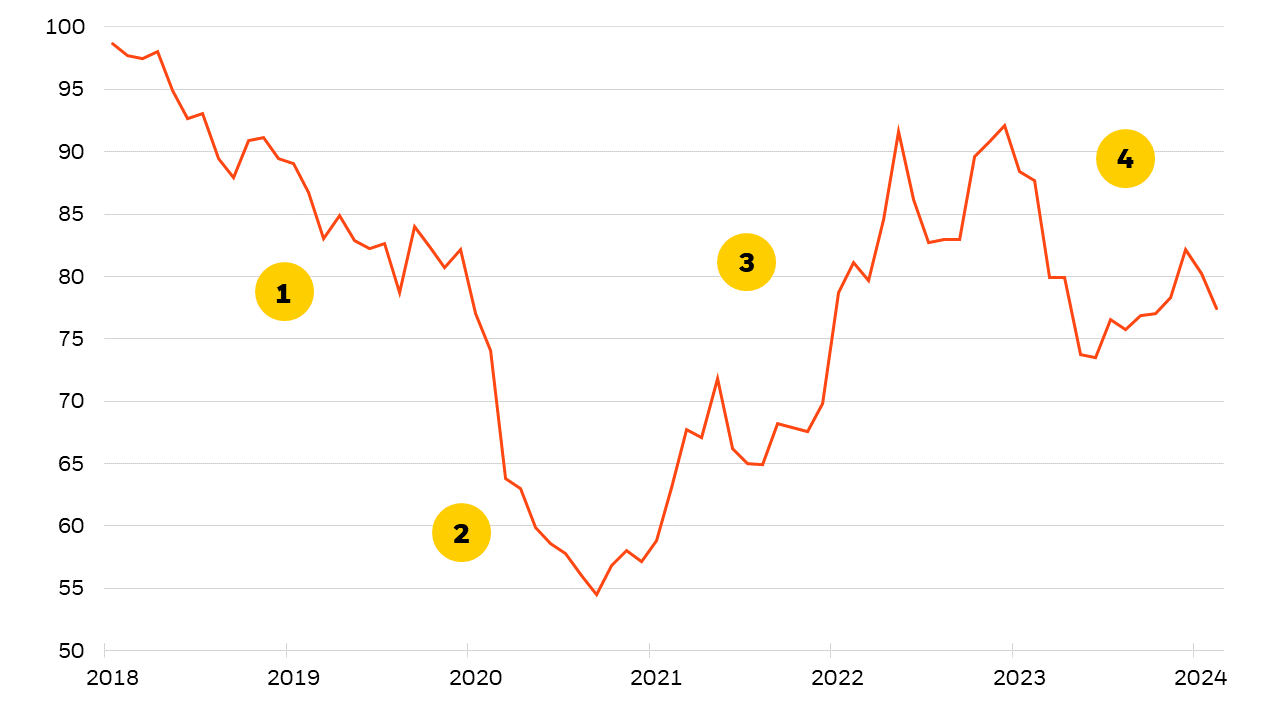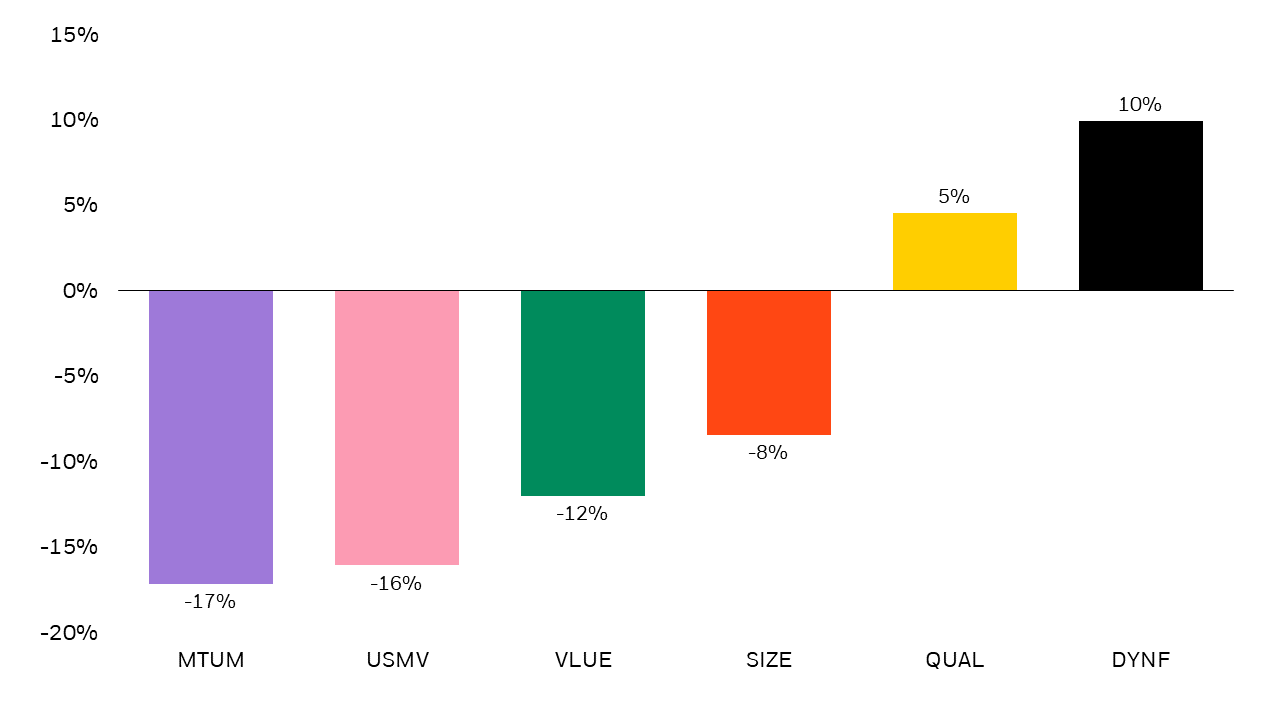Key takeaways
- Timing Factors: Factor returns can be cyclical. Signals like economic regime, valuations, and sentiment could potentially help investors evaluate which factors might be in favor today.
- Play both sides: When a factor looks particularly unattractive, the ability to buy its opposite (i.e., low quality vs. high quality, expensive vs. cheap) unlocks the full investment opportunity set.
- Bottom up: On a practical level, you can time factors by either allocating to single factor sleeves or to individual stocks with the desired factor characteristics. Practitioners call this “top down” and “bottom up” construction, respectively. We prefer the latter, which allows for greater precision and risk management.
To everything there is a season – and factors are no exception. Factors are broad and persistent drivers of risk and return over the long term (which is why we’re such advocates of targeting long-term positive exposure to factors in portfolios), but short-term market conditions can drive different factors in and out of favor. A time to seek, and a time to lose exposure, indeed!
When we started timing factors at BlackRock back in 2016, there was an active debate in the industry and among academics about whether factors vary over time with sufficient predictability to sensibly time them. Today, the debate about there being predictable components in factor returns is largely over.
Over the last eight years of timing factors, we’ve both affirmed and learned some key lessons: factors are cyclical and can be timed; buying the opposite side of a factor can help improve returns; and timing stocks instead of factor sleeves has been the most efficient way to build factor timing portfolios.
Timing Factors
During our years of studying factor cyclicality and running factor timing investment strategies, the performance of the value factor has proved a fantastic case study1. No factor has caused more anguish – and exuberance – over the last half dozen years than value. Its cyclicality, and the drivers behind that cyclicality, shows that factors can be predictable in nature.
Exhibit 1: Cumulative return of value (2018-2024)

Source: BlackRock, with data from Kenneth French (https://mba.tuck.dartmouth.edu/pages/faculty/ken.french/data_library.html) data libraries. Value performance is represented by cumulative monthly return of HML from 1/2018-2/2024. The figure shown relates to past performance. Past performance is not a reliable indicator of current or future results.
- Value’s poor performance during the late-cycle economic environment of 2018-2019 was consistent with economic theory. The best times for value occur early in the economic cycle as large physical stock gives value companies operating leverage. At the late stages of the economic cycle, value companies often have comparatively slower growth, lots of physical infrastructure, and less flexible business models.
- The COVID-19 selloff of 2020 drove poor returns for many styles, but it was especially bad for value. Firms with a lot of physical capital require physical interactions to make money, which drew to a screeching halt during the global lockdown.
- Value made a massive comeback in 2021-2022 during the economic reopening, also very much in line with economic theory. Value typically performs well during the early/recovery stage of an economic cycle - remember that lots of physical capital gives value firms operating leverage.
- The artificial intelligence/machine learning theme that has dominated markets since 2023 has proved a headwind for value. High-growth (and high-quality) Magnificent 7 stocks have consistently led market returns.
Even within this relatively brief time period, the cyclical nature of factors is clear.
Play both sides
Most days I eat nutritious and balanced meals for the benefit of my long-term health and happiness. But sometimes, circumstances call for a cupcake.
Likewise, although factor characteristics have been rewarded over the long term, circumstances might call for anti-factor characteristics in your portfolio over the short term. For example, if you have a negative tactical outlook for value, you might want to avoid cheap stocks today in favor of expensive ones—or consider buying growth!
We’re big believers in broadening the factor timing alpha opportunity set by playing both sides as needed. Many other timing approaches, like sector rotation strategies, aren’t able to do this. Unless you are willing and able to take a short position (which is not, pun intended, an option for many investors), you either own an asset or don’t. The only way to implement a negative tactical outlook for a sector is by underweighting it relative to benchmark or not owning it at all, which is quite limiting.
Some factors have easy single-ticker implementations to play the other side, like buying a mega-cap ETF for the opposite of the size factor. But some are harder to do. You’re not likely to find an ETF that targets unprofitable junk stocks to use as the opposite of quality. Which leads us to…
Bottom up portfolio construction
Another powerful way to broaden the alpha generation opportunity set is to use a “bottom up” portfolio construction approach: start from the stock level and build your way up to a portfolio that has your desired tactical factor tilts. The alternative, which we feel is less optimal, is the “top down” approach that rotates among individual factor sleeves or ETFs.
Unlike binary stock attributes like sector classification (stocks are members of one sector only), factor exposures belong on a spectrum. Every stock has some level of exposure to every factor, and those exposures can be positive or negative. That means you can buy stocks that simultaneously tilt towards the factors you like and away from the ones you have a particularly unfavorable outlook for.
This portfolio construction approach allows you to implement your views using hundreds of stocks, not just a small handful of factor sleeves or ETFs.
Over the years, we’ve found there are several other benefits to using a bottom-up approach. Some of these include the benefit to net positions, superior precision and risk-management capabilities.
Bringing it all together
These three lessons we’ve learned through years of experience – factors can be timed, play both sides, and bottom up portfolio construction – are built into the BlackRock U.S. Equity Factor ETF (DYNF), our actively managed factor timing ETF. Notably, we implemented bottom-up portfolio construction in 2022, and 2023 became a powerful case study for its potential benefits.
Most factors struggled in 2023, with only quality (see Exhibit 2) outperforming the S&P 500 Index. It would have been very difficult for a “top down” factor timing strategy (i.e., rotating among individual factor sleeves) to outperform this year.
Not so for DYNF, which returned 36% in 2023 compared to the S&P 500 Index’s 26% return. That’s almost 1000 basis points of outperformance! Throughout most of the year, DYNF’s portfolio managers favored stocks with high quality, mega cap (anti-size), and high-growth (anti-value) characteristics – precisely the styles that led markets. The combination of “play both sides” and bottom up portfolio construction proved very powerful.
Go active, go factors - go active with factors!
Exhibit 2: 2023 Excess return (vs. S&P 500 Index) of single factor ETFs and DYNF

Source: BlackRock, Morningstar as of 12/31/2023. MTUM is the iShares MSCI USA Momentum Factor ETF. USMV is the iShares MSCI USA Min Vol Factor ETF. VLUE is the iShares MSCI USA Value Factor ETF. SIZE is the iShares MSCI USA Size Factor ETF. QUAL is the iShares MSCI USA Quality Factor ETF. DYNF is the BlackRock U.S. Equity Factor Rotation ETF. Performance data represents past performance and does not guarantee future results. Investment return and principal value will fluctuate with market conditions and may be lower or higher when you sell your shares. Current performance may differ from the performance shown. For most recent month-end performance and standardized performance, click here. Index performance is for illustrative purposes only. Index performance does not reflect any management fees, transaction costs or expenses. Indexes are unmanaged and one cannot invest directly in an index.


